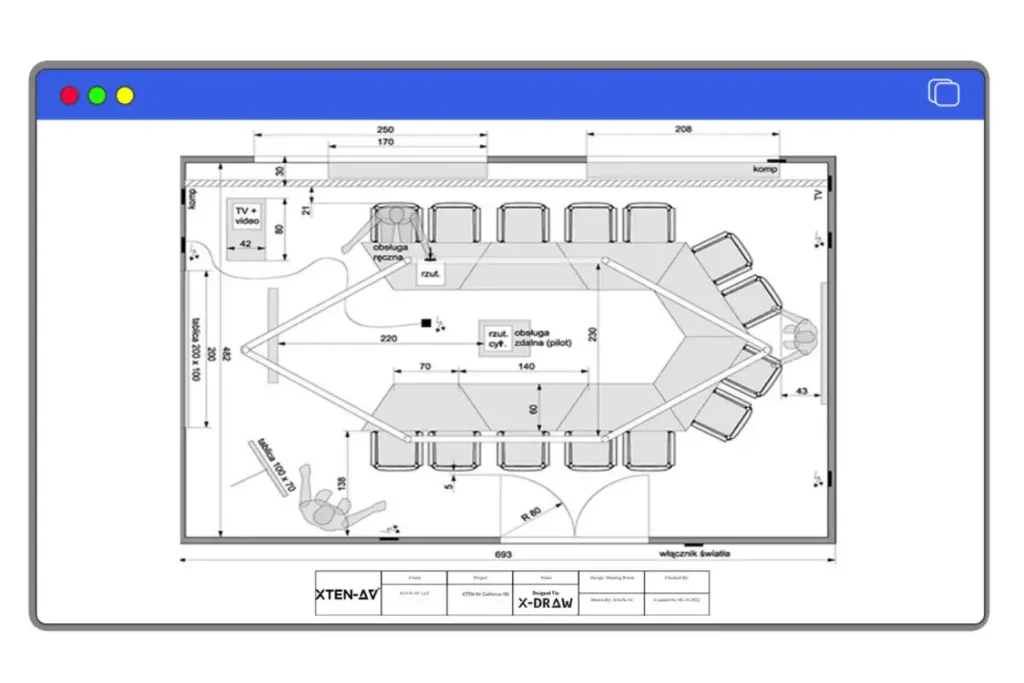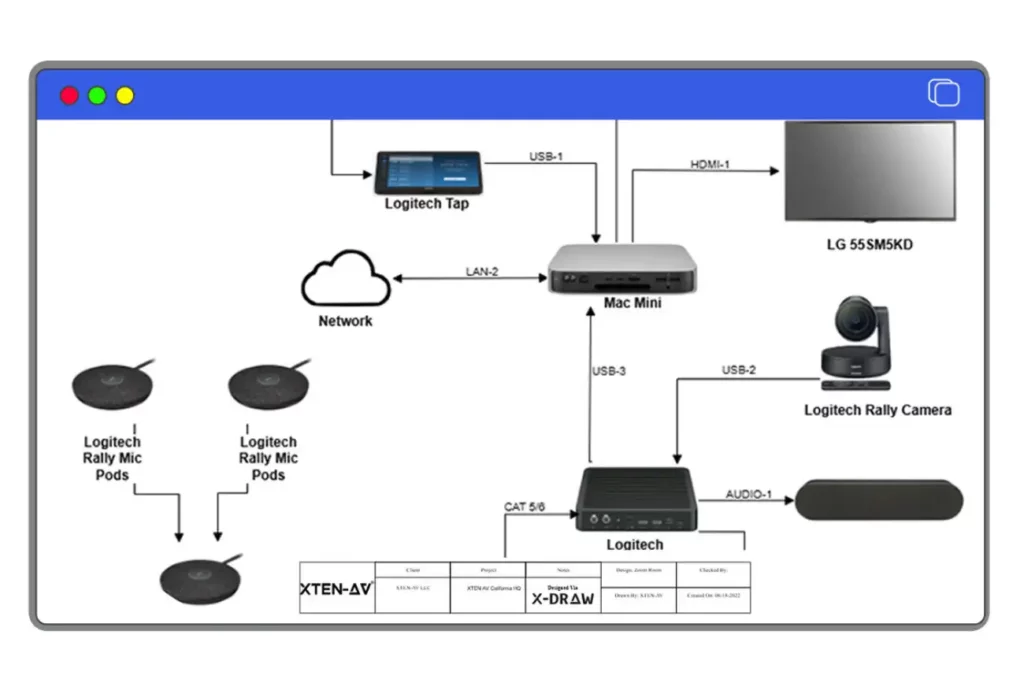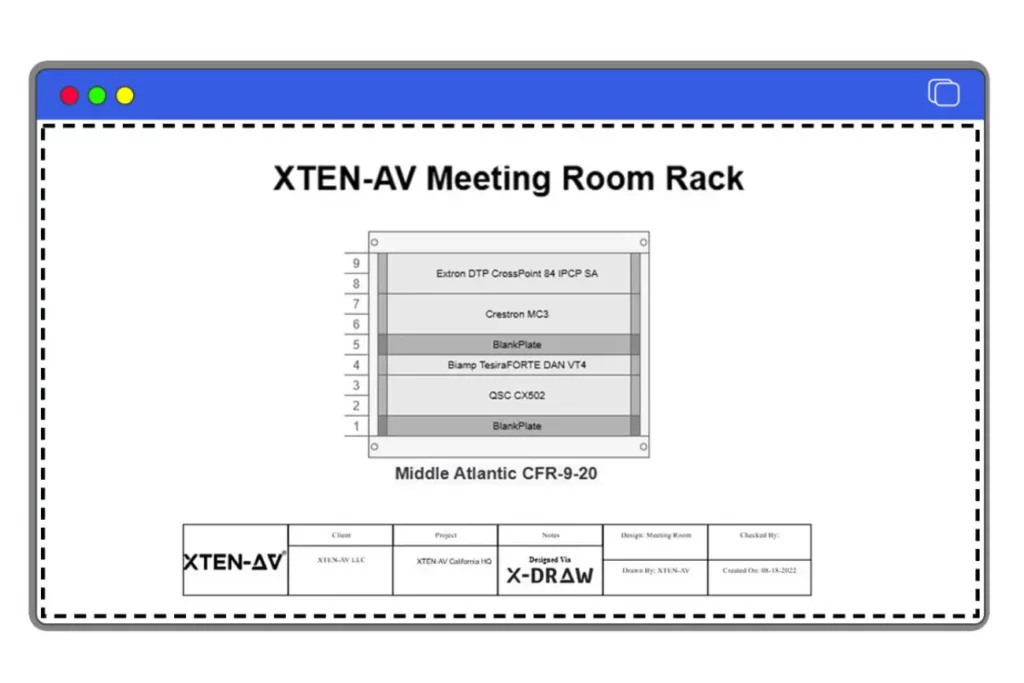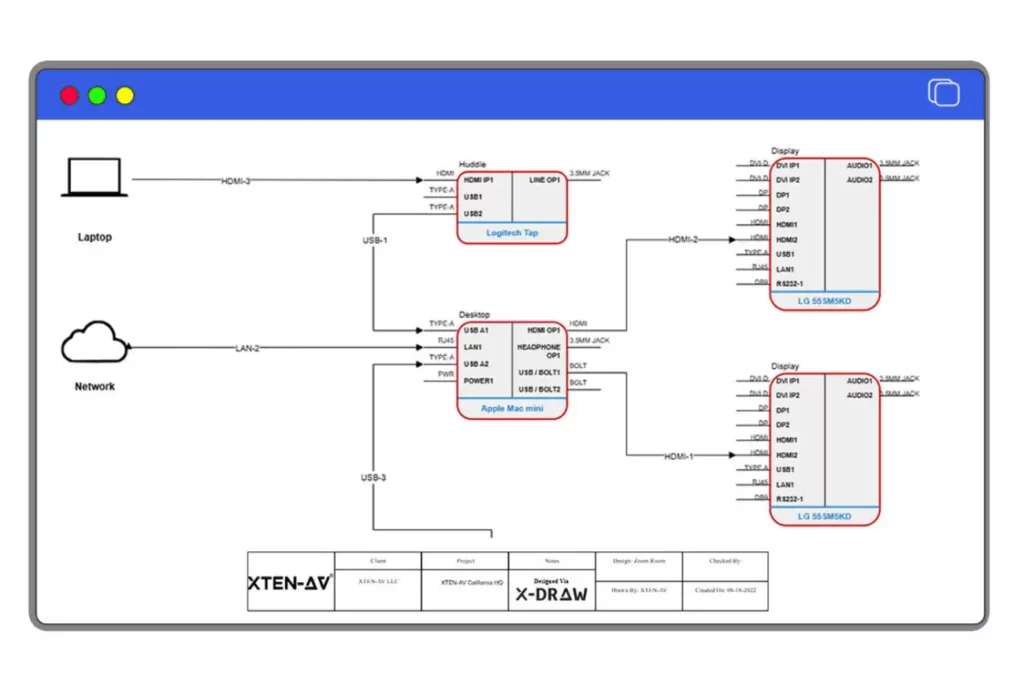AutoCAD remains a cornerstone tool for AV integrators handling complex system design projects. However, understanding accurate AutoCAD pricing often creates confusion across AV project teams and managers.
Subscription and license choices vary widely, ranging from monthly to annual and Flex token–based options. Such billing complexity hides fees and makes budgeting AV deployments unnecessarily difficult.
Despite AutoCAD’s generalist strengths, it lacks AV‑specific symbol libraries and rack layouts. XTEN‑AV reimagines AV CAD by providing transparent pricing and industry‑tailored features out of the box. It’s new XAVIA AI module automates signal‑flow schematics, rack elevation diagrams, and library management.
By focusing solely on AV workflows, XTEN‑AV cuts unnecessary spending and wasted time. In this article, we’ll break down AutoCAD Autodesk cost and explore more innovative AV‑specific alternatives. We will also explore how XTEN‑AV’s subscription plans deliver clearer budgets and superior AV design and integration outcomes. Continue reading to demystify AutoCAD software pricing and learn all about the efficient, cost‑effective CAD with XTEN‑AV.
The all-in-one solution for your AV needs
Transform your audio-visual experience with XTEN-AV.
No Credit Card required
How much does AutoCAD cost for AV integrators?
AutoCAD’s versatility appeals to AV integrators managing complex audiovisual system design projects daily. Yet, precise AutoCAD subscription price estimations often cause frustration among AV budgeting teams. AV environments require multiple licences, cloud access, and collaboration features for seamless workflows.
Autodesk offers AutoCAD monthly subscription pricing at approximately $260 per named user each month. For longer commitments, AutoCAD pricing per year is $2,095 per user. A three‑year term reduces yearly rates but requires an upfront bulk payment for cost savings.
AV integrators balancing cash flow may choose Autodesk Flex token‑based usage models instead. Flex consumes seven tokens daily, equivalent to roughly twenty‑one dollars per active usage day.
Token purchase options include 100-token bundles at $300 or 500 tokens for a total investment of $1,500. This token structure benefits occasional collaborators or part‑time users within diverse AV teams.
AutoCAD multiuser license price or enterprise price comprises custom pricing, custom billing, and customized support. These plans typically include directory synchronization, centralized billing & payments, and a unique collaborative environment for larger companies. AV managers should compare subscription, annual, and token plans to budget effectively.
Each pricing model has a separate impact on the total cost of ownership for AV system deployments. For detailed annual and monthly fee analysis, check our AutoCAD subscription price resource online today. AV integrator budgets depend heavily on selecting the right subscription and payment model.
Here is a price comparison table for AutoCAD and XTEN-AV’s pricing to provide you with clarity:
Features | AutoCAD | XTEN-AV |
Pricing model | Subscription Based | Subscription Based |
Monthly Cost | $175.96 per user | Basic: $66 per user Business: $72 per user |
Annual Cost | $1394.12 per user | Basic: $49 per user Business: $54 per user |
Free Trial | Available for 15 days | Available for 15 days |
No Credit Card required
Why does AutoCAD Cost So Much?
AutoCAD’s legacy status as a general drafting platform increases its perceived licensing fees. AV integrators rely on AutoCAD to create rack layouts and signal-flow CAD schematics daily.
Despite its versatility across industries, AV designs receive little tailored functionality support. Enterprise customers regularly invest in premium support and extended update services.
Broad Feature Set
AutoCAD’s broad feature set includes modules that are entirely irrelevant for AV-centric system design. Architecture, mechanical, and mapping toolsets inflate subscription pricing without any AV value.
Including every tool drives unnecessary license costs and substantially inflates overall billing. AV pros pay for functionalities they seldom use in their critical, day-to-day workflows. You’re paying for what you don’t use when AV requirements are minimal.
Licensing Structure
AutoCAD subscription plans range from monthly to annual to Flex token‑based billing models. Monthly pricing averages around $260 per user under standard license agreements.
Annual commitments lower per‑seat fees but require larger upfront payments for plans. Flex tokens offer pay‑as‑you‑go options at roughly seven tokens per active user day.
AV system designers sometimes favor Flex to align billing with sporadic usage demands better. Enterprise and multi user license arrangements often require custom quotes and negotiated fee structures. Bundled subscriptions lock AV teams into expensive fees for seldom-used modules.
Training and Onboarding Requirements
Mastering AutoCAD demands significant training investments for AV system engineers and drafters. The complexity of the interface and toolsets extends onboarding timelines and raises internal fees.
Many firms invest in certification courses alongside custom workflow development for teams. These training costs add to subscription expenses, inflating overall project budget estimates.
Extended onboarding delays project kickoff and significantly increases overall indirect labour fees. Companies often overlook these hidden training expenditures during the initial planning phase for purchasing.
Lack of Built-in AV Libraries and Templates
AutoCAD lacks comprehensive AV symbol libraries and rack templates out of the box. As a result, audiovisual system integrators must manually build signal-flow CAD diagrams and AV-specific CAD drawings for every project. This becomes a laborious process.
Third‑party plugins or custom scripting incur additional subscription fees every renewal cycle. The development of custom resources further inflates billing through one-time and maintenance charges. These overheads prolong design workflows and erode overall project profitability for integrators.
You’re paying for functionality you rarely need in AV‑specific system deployments daily. Recognizing these core drivers clarifies why you’re paying for what you don’t use.
AV Design Mastery + Winning Proposals = 10x Productivity!
- Automatic Cable Labeling & Styling
- 100+ Free Proposal Templates
- Upload & Create Floor Plans
- 1.5M Products from 5200 Brands
- AI-powered ‘Search Sense'
- Legally Binding Digital Signatures
No Credit Card Required
The AutoCAD Hidden Costs No One Talks About
Aside from conventional subscription and license fees, AutoCAD also conceals a number of operational costs for AV Integrators. Identifying these hidden licensing costs can have a significant impact on yearly budgeting and project profitability.
1. Learning Curve & Onboarding Time
New AV engineers experience severe learning curves with AutoCAD. They learn to use a mixed toolbox and related user interface (UI). Onboarding newer employees takes time, and delays their ability to start working on projects, while they also incur the costs of training needed.
Typically, firms will register employees to get a certification, which adds to the total cost. The longer it takes for the new employee to onboard, the more they cost projects, and the less they can bill for billable work on the project.
2. Manual CAD Workflows (No Automation)
Without automation, repetitive drafting tasks demand substantial manual effort on every AV project. Dimensioning, layer management, and symbol placement lack intelligent assistance, which slows down design cycles.
Audio visual integrators must allocate labor hours to tasks that they can automate instead. This manual workload directly translates into higher labor fees across design plans. Over time, these inefficiencies accumulate, compounding total project expenses.
3. Missing AV Symbol Libraries
AutoCAD lacks built‑in AV symbol libraries and templates needed for efficient design. Users must create or source AV‑specific CAD features manually before drawing rack layouts. These development efforts incur additional license fees for third‑party plugins or internal scripting.
AV designers spend hours assembling custom blocks rather than focusing on system design and optimization. Explore XTEN‑AV’s comprehensive AV symbol libraries for CAD to eliminate these unnecessary expenses.
4. Team Collaboration Friction
Collaborative AV design typically requires multiple singular licenses and manual file-sharing systems. Version control issues occur when designers combine DWG files in separate environments.
Interoperable AV design collaborations involve unwarranted labor costs because reconciling ones and zeroes requires more time. Cloud storage doesn’t generally integrate easily, has lagging review and approval loops, and sometimes seems antiquated as a result.
Missing collaboration opportunities can lead to lost productivity and have a significant impact on project billing.
5. Frequent Back-and-Forth with Non-Integrated Tools
AutoCAD doesn’t integrate natively with AV estimation, documentation, or project management platforms. Designers export drawings, update separate reports, and then manually reconcile inconsistencies.
These iterative actions only cause increased errors and rework, as well as hidden labor expenses in plans. Each reconciliation cycle that requires completion adds to the time for projects and indirectly increases subscription renewal fees. Integrators will need to include this tool’s friction when calculating the actual cost of projects.
6. Time Spent on Rack Layouts & Schematics Manually
Crafting detailed rack layouts and signal‑flow schematics in AutoCAD’s generic environment consumes excessive time. Without optimized templates, each diagram demands bespoke layering and annotation.
AV teams often repeat these tasks for every project phase, unnecessarily multiplying labor hours. These manual processes result in lost opportunity costs for revenue-generating activities elsewhere. Recognizing these hidden time drains underscores the need for AV-focused automation solutions moving forward.
Understanding these concealed expenses reveals how traditional CAD license plans mask significant operational costs. You’re paying for not only software access but also time‑intensive workflows and tool friction.
Enter XTEN-AV: A Purpose-Built Alternative
XTEN-AV is unique CAD software deliberately designed for AV integration professionals. XTEN-AV is not just another solution, the way AutoCAD is with its rollercoaster of pricing and overcomplicated licensing processes.
By focusing on AV workflows, XTEN‑AV provides clear subscription plans with transparent billing details. AV designers and installers now have access to domain-specific tools without having to pay for irrelevant, generic modules.
Designed for AV Integrators
XTEN‑AV’s core functionality centers on AV-specific CAD features trusted by integration teams. Prebuilt rack layouts and equipment templates match industry standards out of the box. Signal-flow diagrams arrive preconfigured, eliminating the need for manual block creation and reducing customization fees.
AV integrators avoid paying bloated generic license fees tied to unused architectural modules. The platform’s AV‑focused design reduces onboarding time and streamlines system validation processes.
Customizable equipment libraries simplify project planning and significantly reduce labor costs every cycle. By eliminating unnecessary toolsets, XTEN‑AV decreases annual subscription costs and reduces hidden fees.
This design‑first approach redefines AutoCAD cloud pricing expectations for AV professionals seeking efficiency.
Integrated Cloud Workflows
XTEN-AV’s cloud collaboration architecture utilizes secure, real-time multi-user editing to enable simultaneous collaboration by teams of professionals. Automated version control prevents conflicts and eliminates the need for time-consuming manual merging.
A single centralized subscription charge streamlines license management for global enterprise AV integration firms. Administrators can instantly assign and revoke user access, reducing administrative overhead and unexpected fees.
Cloud‑native storage ensures dependable uptime and data redundancy for critical project assets. Each team shares templates and edits in real time, providing faster review cycles and quicker iterations which allow for better client approvals.
In this integrated environment, you won’t have to rely on third-party syncing products that you have to pay for. Even more importantly, the cloud-based efforts of XTEN-AV virtually eliminate coordination issues and lower costs.
Smart Automation
XTEN‑AV’s intelligent automation engine removes repetitive drafting tasks from every AV project. Built‑in macros automate layer assignments, dimensioning, and annotation uniformly across drawings.
Automated clash detection and system validation checks catch design errors before construction begins. These automated processes reduce manual labor hours and substantially shrink overall project billing.
AV teams experience faster turnaround times and increased design consistency across iterations. Reducing human error through automation lowers expensive rework fees and on‑site troubleshooting costs.
With XTEN-AV, integrators can redeploy design hours toward high-value tasks and revenue-generating activities. This smart automation approach redefines expectations for modern AV CAD subscription plans.
Showcase XAVIA AI Engine
XAVIA auto‑generates AV CAD drawings based on simple system specifications entered by users. It understands complex signal-flow requirements and automatically configures device connections each time.
The AI learns from historical projects to suggest optimized layouts for future designs. XAVIA’s predictive algorithms reduce iteration cycles by generating intelligent default templates instantly.
AV professionals experience fewer manual adjustments and significantly lower labour fees per project cycle. By adapting to unique equipment inventories, XAVIA ensures consistent CAD outputs and fewer errors.
Its seamless integration into XTEN‑AV’s cloud workflows removes additional training and support fees. This AI‑driven automation positions XTEN‑AV as the most efficient alternative to generic CAD plans.
Real‑World Use Case
Imagine an AV integration firm is using traditional CAD drawing software like AutoCAD. As a result, it experiences issues with AV system design, proposal creation, high error rates, and delayed updates. The firm is also unable to manage budget for AV system design, faces time-consuming client engagement, lower margins on services, and other obstacles.
However, the firm switched to XTEN-AV, an AI-powered CAD drawings solution featuring modern AV design software. As a result, it reduces the proposal drafting time by half and error rate by over 30% during system validation.
The software also features shared cloud templates and streamlined collaboration, eliminating costly version conflicts and coordination delays. Transparent subscription plans provided predictable budgeting for licenses, support, and update fees.
Designers refocused saved hours on client engagement and higher‑margin system optimization services. Project managers tracked progress in real time, minimizing unforeseen billing spikes during deployments.
XTEN-AV’s dedicated platform improved overall project quality while cutting total operating expenditures. This case demonstrates that domain-specific software consistently outperforms generic software across the board.
XTEN-AV reimagines AutoCAD pricing, combining A-specific functionality with AI-guided automation. It delivers faster outcomes, more intelligent workflows, and lower total fees compared to generic CAD.
XTEN-AV vs AutoCAD: The Honest Comparison of pricing and features
AutoCAD’s monthly subscription starts at $245 per user, reflecting AutoCAD pricing of legacy models. The annual price for AutoCAD is approximately $1,955 per named user each year.
Enterprise and multi-user access often require custom quotes and negotiated billing structures. XTEN‑AV offers transparent monthly pricing from $50 to $99, improving cost predictability. Annual XTEN-AV plans range from $600 to $999, streamlining subscription management for AV teams.
Every XTEN‑AV plan comprises multi-user access at no additional license charge. AutoCAD lacks AV-specific CAD features, such as symbol libraries, rack layouts, and templates.
XTEN‑AV integrates built‑in AV symbol libraries and rack templates to eliminate manual creation. Signal flow design tools in XTEN‑AV replace cumbersome AutoCAD workflows for AV projects. XTEN‑AV’s AI engine XAVIA auto-generates CAD drawings based on system specifications automatically.
XAVIA recognizes complicated signal flows and recommends layouts with the shortest delivery path. Intelligent automation will reduce drafting time, producing fewer labor hours and lowering total labor costs.
The built-in validation checks will eliminate design mistakes and reduce time spent on system validation cycles. XTEN‑AV’s cloud collaboration enables users to work on group files, avoids duplication of effort, and eliminates version confusion. Overall, XTEN‑AV delivers faster proposals, consistent outputs, and transparent billing for integrators.
Here is a side-by-side comparison table for your better understanding.
Feature / Plan | AutoCAD | XTEN‑AV |
Monthly Price | $245 | $50–$99 |
Annual Price | $1,955 | $600–$999 |
Multi‑User Access | Enterprise only | Included |
AV Symbol Library | ❌ | ✅ |
Rack Layouts | ❌ | ✅ |
Signal Flow Design | ❌ | ✅ |
AI Design Generator | ❌ | ✅ (XAVIA) |
AV Templates | ❌ | ✅ |
Free Trial | ✅ | ✅ |
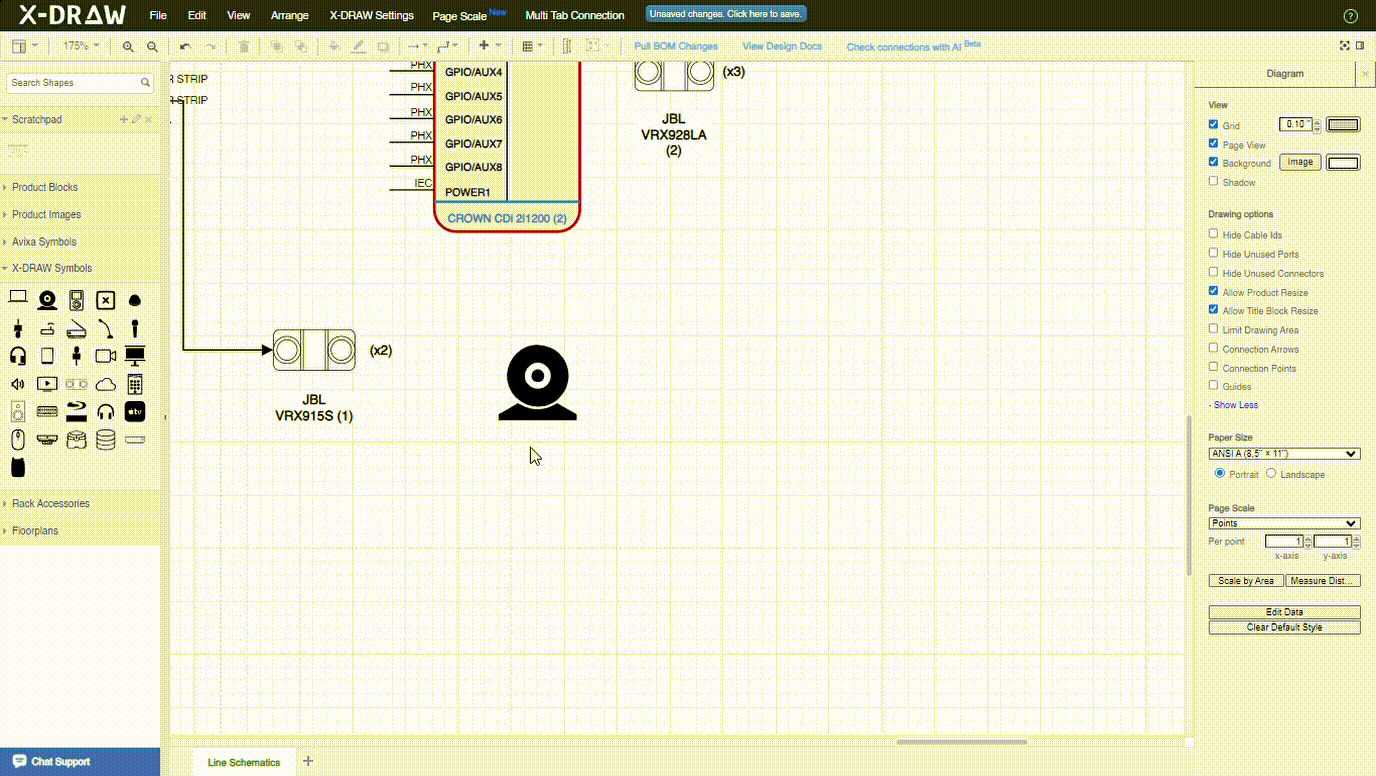
No Credit Card required
Conclusion
AutoCAD’s comprehensive subscription plans introduce unnecessary complexity for targeted AV integration workflows. Besides paying more, you’re also working harder managing generic modules that AV professionals ignore.
On the other hand, XTEN‑AV offers purpose‑built subscription pricing tailored to AV needs, powered by AI‑driven automation. The platform includes built‑in AV symbol libraries, rack layouts, and signal‑flow templates instantly.
Transparent billing and predictable license fees eliminate hidden expenses tied to extraneous features. With XTEN‑AV, teams complete proposals faster and validate systems accurately every time.
So, what are you waiting for? Experience smarter AV CAD by registering for a 15‑day free trial period or booking a free demo. Embrace cost‑efficient, domain‑specific design workflows that outperform legacy CAD tools and boost project profitability today.
FAQs
AutoCAD’s pricing reflects its legacy as an all‑purpose CAD platform serving architecture, engineering, and manufacturing industries. Its subscription and license fees bundle dozens of specialized toolsets, many irrelevant for AV workflows, driving up costs.
Autodesk’s tiered plans include monthly, annual, and Flex options, but if you add complexity and hidden fees, you inflate total cost of ownership far beyond base subscription rates.
AutoCAD is not available for free to commercial users. Autodesk offers a 30‑day free trial of full‑featured software, after which user requires a paid subscription. Educational and student versions are free under Autodesk’s Education Community.
However, these versions carry watermarks and non‑commercial terms. For permanent commercial use, businesses must purchase a valid license or subscription.
For broad design disciplines, AutoCAD remains a powerful drafting tool in 2025. However, AV integrators may find its generic feature set and high subscription fees disproportionate to their needs.
Teams requiring 2D drawings and basic schematics might benefit more from domain‑specific tools like XTEN‑AV, which offer built‑in AV symbol libraries, rack layouts, and AI‑powered automation at lower total cost of ownership.
Cheaper alternatives include XTEN‑AV for AV professionals, offering transparent subscription plans starting at $50 per month. Other low‑cost options are BricsCAD and DraftSight, which may suit general drafting needs but lack AV‑specific features.
Open‑source tools like LibreCAD can address basic 2D CAD requirements but don’t provide industry‑tailored symbol libraries or AI‑powered workflows essential for AV system design.
XTEN‑AV outperforms AutoCAD for AV integration by focusing exclusively on audiovisual workflows. It includes built‑in AV symbol libraries, rack layouts, and signal‑flow templates. Its AI engine, XAVIA, auto‑generates CAD drawings and learns from past designs. This domain‑specific focus reduces subscription and labor fees, streamlines collaboration, and delivers predictable billing compared to AutoCAD’s broad licensing structure.
Small businesses with limited CAD needs may find AutoCAD’s monthly and annual subscription fees prohibitive. Its extensive toolsets and licensing complexity introduce unnecessary costs for basic 2D drafting.
Alternatives like XTEN‑AV offer cost‑effective plans tailored to AV professionals, delivering essential features and AI‑powered automation at lower price points, improving ROI and reducing hidden customization and implementation fees.
Yes, XTEN‑AV can fully replace AutoCAD for most AV integration workflows. It provides all necessary AV-specific CAD features. These features include rack layouts, signal‑flow design, and symbol libraries within a single platform.
XTEN-AV’s AI‑powered XAVIA engine automates repetitive tasks, eliminating manual drafting. Built‑in cloud collaboration and transparent subscription plans ensure a seamless transition away from legacy CAD licensing complexity.
The best CAD solution for AV professionals is XTEN‑AV, thanks to its domain‑specific features and AI‑driven automation. Its purpose‑built AV symbol libraries, rack layouts, and signal‑flow templates address AV workflows precisely.
While general CAD tools like AutoCAD remain powerful, XTEN‑AV’s streamlined subscription plans and automated processes deliver superior efficiency and cost‑effectiveness.
Absolutely. You can design AV systems without AutoCAD using XTEN‑AV, which offers built‑in AV symbol libraries, rack templates, and signal‑flow automation. Its AI engine XAVIA auto‑generates drawings from system specifications, eliminating manual DWG drafting.
Cloud collaboration tools and real‑time updates further streamline workflows. This specialized platform removes dependency on generic CAD tools like AutoCAD for AV design.
Switching from AutoCAD’s $245 monthly subscription to XTEN‑AV’s $50–$99 plans can save AV teams up to 80% on software fees. Annual savings range from $1,200 to $2,100 per seat.
Additional reductions come from lower training overhead and eliminated third‑party plugin costs. Over a year, an integrator with five seats could save up to $12,000 in license fees alone.
For AV consultants and freelancers with specialized needs, AutoCAD’s broad toolsets often exceed workflow requirements. Its subscription and licensing fees can strain smaller budgets.
XTEN‑AV offers a cost‑efficient alternative with built‑in AV features and AI automation, reducing hourly drafting time and subscription costs. Freelancers gain faster proposals and consistent outputs without paying for unused modules.
Yes, XTEN‑AV provides a 15‑day free trial with full access to its AV‑specific CAD features and XAVIA AI engine. Users can also book a personalized demo to explore rack layouts, signal flows, and symbol libraries in real time. These options allow AV professionals to evaluate the platform’s efficiency, collaboration tools, and transparent subscription pricing before committing.
AutoCAD subscription pricing starts at approximately $245 per user per month or $1,955 per user per year. Longer commitments, such as three‑year plans, reduce per‑seat costs but require significant upfront payments. Autodesk Flex token‑based billing is also available, charging roughly $21 per day of active use, depending on token bundles and consumption rates.
Yes, Autodesk offers a 30‑day free trial for AutoCAD’s complete feature set. During this period, users can access all drafting and automation tools without restrictions. After the trial, user requires a paid subscription or license for continued commercial use. The trial helps teams evaluate core functionalities but doesn’t include industry‑specific workflows like XTEN‑AV’s AV features.
No, AutoCAD is only available via subscription models. Autodesk discontinued perpetual licenses in favor of monthly, annual, and Flex token‑based plans. This shift ensures continuous updates but locks users into recurring billing cycles. Organizations seeking perpetual licensing must consider legacy versions or alternative CAD platforms offering one‑time purchase options.
AutoCAD LT is a streamlined 2D drafting version of AutoCAD lacking advanced customization, 3D, and automation features. It’s subscription costs about $55 per month or $440 annually, significantly cheaper than full AutoCAD. However, LT’s limited toolset may not support complex AV symbol libraries, rack layouts, or signal‐flow automation required by integration professionals.
Free and open‑source CAD options include LibreCAD, FreeCAD, and QCAD. These tools support basic 2D drafting but lack specialized AV-specific CAD features, AI automation, and robust collaboration found in XTEN‑AV. While cost‑free, they require manual setup of symbol libraries and templates, increasing labor fees and reducing productivity for AV system design projects.
AutoCAD’s pricing saw a modest increase of roughly 5% in early 2025, reflecting expanded cloud services and updated toolsets. Monthly fees rose to approximately $245 from $235, while annual plans climbed to $1,955 from $1,900 per user. These adjustments maintain Autodesk’s recurring revenue model but further challenge AV budgets already stretched by generic license fees.
Yes, Autodesk offers free AutoCAD licenses to students and educators through its Education Community. Valid academic email addresses grant one‑year licenses renewable annually for non‑commercial learning purposes. These versions include full functionality but carry educational watermarks and usage restrictions that prohibit professional or commercial use outside academic settings.

